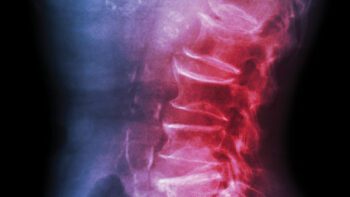By Glenn Gonzalez, MD, Thomas Jefferson University
John V. Wainwright, MD, Westchester Medical Center Health Network/New York Medical College
Sara Thalheimer, BA, Thomas Jefferson University
James S. Harrop, MD, MSHQS, Thomas Jefferson University

Overview
The motion and alignment of the neck are crucial for overall spinal health. The neck, also known as the cervical spine, consists of seven vertebrae and associated discs that support the head and allow it to move freely. The neck also allows for changes in head position and permits vertical and horizontal gaze (looking in all directions). Proper motion and alignment of the neck are necessary for optimal functioning of the spine, maximizing the line of sight, as well as for overall physical and mental well-being.
Proper Alignment
When the neck is properly aligned, the head is centered over the shoulders while the shoulders remain level, and the remainder of the spine is in a neutral position (Figure 1). This creates a load pattern where the muscles in the back of the neck are relaxed and not subjected to many forces. After birth, the cervical spine develops a natural curvature (cervical lordosis) as we begin to hold our heads up to eat and interact with our environment.1 This curvature (lordosis), provides for the proper distribution of weight and balances the pressures exerted on the spine, which helps to prevent injury and pain.

When properly aligned, the curvature of the cervical spine and the complimentary curves in the remainder of the spine allow the weight of the head and trunk to be passed through the vertebrae in the front of the spine, to the pelvis, and lastly through the legs to the ground. Proper alignment of the neck minimizes the forces and stress on the vertebrae, discs, joints, and muscles in the neck. This may reduce the development of degenerative conditions of the neck including arthritis, degenerative disc disease, disc herniations, spinal stenosis, and neck pain. Additionally, proper alignment of the neck protects the spinal cord from compression (unnatural pressure).
Proper Motion
The cervical spine is designed to move in several directions:
- Bending forward (flexion)
- Bending backward (extension)
- Turning the head (rotation)
- Bending the head to the side (lateral bending)
Proper motion is essential for normal function and spine health. These movements allow one to perform a wide range of actions, such as looking up and down, turning the head to look in different directions, and nodding and shaking the head.
Improper Alignment and Motion
Injury, poor posture, and degenerative conditions of the neck can alter this normal motion and create stress on the various structures of the neck. This can lead to degenerative disc disease, disc herniations, and arthritis of the neck which can result in pain from pinched nerves or pressure on the spinal cord. One common biomechanical situation we see in the clinic is the development of a forward position of the neck (kyphosis) which can start from simple poor posture (see infographic here).
Prolonged poor posture can occur with everyday activities, such as:
- Sitting at a desk looking down and leaning the neck forward to view a computer screen that is poorly aligned with one’s natural line of sight over extended periods of time
- Prolonged cell phone use with leaning the head forward and/or to the side repeatedly through the day
Prolonged poor posture can result in:
- Muscle strain in the neck and shoulders and pressure on the joints of the neck resulting in pain and even headaches
- Premature degeneration of the cervical spine over time
- Stress on the discs in the neck which can lead to disc herniations and pinched nerves
- Permanent structural changes to the neck — the loss of the normal cervical curve (lordosis) and the neck leaning forward into kyphosis
- The development of a kyphotic deformity, which is exacerbated and worsened by the forces of gravity heavily weighing down on the posterior portion of the neck
Neck Essentials
It is very important to maintain proper neck alignment and motion before permanent problems occur. One technique to prevent these issues is to practice correct posture and ergonomics. This includes sitting and standing with the shoulders back and the head level, looking straight and avoiding prolonged periods of inactivity.2,3,4 Additionally, taking regular breaks when seated or watching a screen for extended periods is important. Stretching and strengthening exercises for the neck and upper back can also help to maintain proper alignment and motion.
It is also essential to be mindful of any neck pain or discomfort and seek medical attention if necessary. Underlying conditions that may cause neck pain, poor alignment, or abnormal motion can be diagnosed and treated by a doctor or physical therapist. Specific stretches and exercises to help improve neck range of motion and alignment can be tailored to the individual.
In conclusion, the motion and alignment of the neck are important for overall spinal health. Proper motion and alignment are necessary for the spine to function normally and can help prevent injury and pain. It is crucial to maintain appropriate neck alignment by practicing good posture and ergonomics and engaging in regular stretching and strengthening exercises. Taking care of your neck today can help ensure that your spine remains healthy and functioning properly in the future. As always, seek medical attention if necessary.
References
- Kasai, Tokio MD; Ikata, Takaaki MD; Katoh, Shinsuke MD; Miyake, Ryoji MD; Tsubo, Masahiko MD. Growth of the Cervical Spine With Special Reference to Its Lordosis and Mobility. Spine 21(18): p 2067-2073, September 15, 1996.
- Diab AA, Moustafa IM. The efficacy of forward head correction on nerve root function and pain in cervical spondylotic radiculopathy: a randomized trial. Clinical Rehabilitation. 2012; 26(4): 351-361. doi: 10.1177/0269215511419536
- Cagnie B, Danneels L, Van Tiggelen D, De Loose V, Cambier D. Individual and work related risk factors for neck pain among office workers: a cross sectional study. Eur Spine J. 2007 May; 16(5): 679-86. doi: 10.1007/s00586-006-0269-7. Epub 2006 Dec 8. PMID: 17160393; PMCID: PMC2213555.
- Green BN. A literature review of neck pain associated with computer use: public health implications. J Can Chiropr Assoc. 2008 Aug; 52(3): 161-7. PMID: 18769599; PMCID: PMC2528269.



